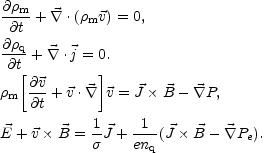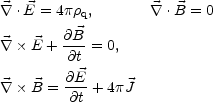


4.3. From one-fluid equations to MHD
The evolution equations for the one-fluid variables are obtained from the two-species kinetic description by some algebra which is summarized in the first part of Appendix A. The bottom line of the derivation is that the moments of the one-particle distribution function obey a set of partial differential equations whose solutions can be studied in different approximations. One of these approximations is the MHD description. The set of one-fluid equations (derived in Appendix A) can be written as
 |
(4.14)
|
supplemented by the Maxwell's equations
 |
(4.18)
|
Eqs. (4.14) and (4.15) are the mass and charge conservation, Eq. (4.16)
is the equation for the momentum transfer and Eq. (4.17) is the
generalized Ohm law. In Eqs. (4.14)-(4.17)
 is the
one-fluid velocity field, P is the total pressure and
Pe is the pressure of the electrons.
is the
one-fluid velocity field, P is the total pressure and
Pe is the pressure of the electrons.
If the plasma is globally neutral the charge density can be
consistently neglected.
However, global neutrality is plausible only for typical lengths much
larger than
 D where the
collective properties of the plasma are the leading
dynamical effect. Under this assumption, Eqs. (4.15) and (4.18) imply
D where the
collective properties of the plasma are the leading
dynamical effect. Under this assumption, Eqs. (4.15) and (4.18) imply
 |
(4.21) |
which means that MHD currents are, in the first approximation, solenoidal.
The second step to get to a generalized form of the MHD equations is to neglect the terms responsible for the high frequency plasma excitations, like the displacement current in Eqs. (4.20) whose form becomes then
 |
(4.22) |
Given the two sets of consistent
approximations discussed so far, the form taken by the generalized Ohm law
may not be unique and, therefore, different MHD descriptions
arise depending upon which term at the right hand side of Eq. (4.17)
is consistently neglected. The simplest (but often not realistic)
approximation
is to neglect all the terms at the right hand side of Eq. (4.17). This
is sometimes called ideal MHD approximation. In this case
the Ohmic electric field is given by

 -
-
 ×
×
 .
This ideal description is also called sometimes superconducting MHD
approximation since, in this case, the resistive terms in
Eq. (4.17), i.e.
.
This ideal description is also called sometimes superconducting MHD
approximation since, in this case, the resistive terms in
Eq. (4.17), i.e.
 /
/
 go to zero
(and the conductivity
go to zero
(and the conductivity 

 ). In the early Universe
it is practical to adopt the superconducting approximation
(owing to the large value of the conductivity) but it is also
very dangerous since all the
). In the early Universe
it is practical to adopt the superconducting approximation
(owing to the large value of the conductivity) but it is also
very dangerous since all the
 (1 /
(1 /
 ) effects are dropped.
) effects are dropped.
A more controllable approximation is the real (or resistive) MHD.
The resistive approximation is more controllable since the small
expansion parameter (i.e. 1 /
 ) is not zero (like in
the ideal case)
but it is small and finite. This allows to compute the various quantities
to a a given order in 1 /
) is not zero (like in
the ideal case)
but it is small and finite. This allows to compute the various quantities
to a a given order in 1 /
 even if, for practical
purposes, only the first correction is kept.
In this framework the Ohmic current is not neglected and the
generalized Ohm law takes the form
even if, for practical
purposes, only the first correction is kept.
In this framework the Ohmic current is not neglected and the
generalized Ohm law takes the form
 |
(4.23) |
Comparing Eq. (4.23) with Eq. (4.17), it is possible to argue
that the resistive MHD scheme is inadequate whenever the Hall and
thermoelectric terms are cannot be neglected. Defining
 B = eB
/ m as the Larmor frequency, the Hall term
B = eB
/ m as the Larmor frequency, the Hall term
 ×
×
 can be neglected
provided L
can be neglected
provided L
 p2
/
p2
/  B
v0 >> 1 where
L us the typical size of the system and v0 the
typical bulk velocity of the plasma. With analogous
dimensional arguments it can be argued that the pressure gradient,
i.e. the thermoelectric term, can be consistently
neglected provided Lv0
B
v0 >> 1 where
L us the typical size of the system and v0 the
typical bulk velocity of the plasma. With analogous
dimensional arguments it can be argued that the pressure gradient,
i.e. the thermoelectric term, can be consistently
neglected provided Lv0
 B
me / Te >> 1. Specific
examples where the Hall term may become relevant will be discussed in
the context of the Biermann battery mechanism.
B
me / Te >> 1. Specific
examples where the Hall term may become relevant will be discussed in
the context of the Biermann battery mechanism.
The set of MHD equations, as it has been presented so far,
is not closed if a further relation among the different variables is not
specified
[87].
Typically this is specified through an equation relating pressure and
matter density (adiabatic or isothermal closures). Also the
incompressible closure (i.e.
 .
.  = 0)
is often justified in the context of the evolution of magnetic fields
prior to recombination. It should be stressed that sometimes the
adiabatic approximation may lead to paradoxes. It would correspond, in
the context of ideal MHD, to infinite electrical conductivity and
vanishingly small thermal conductivity (i.e. the electrons should be
extremely fast not to feel the resistivity and, at the same time,
extremely slow not to exchange heat among them).
= 0)
is often justified in the context of the evolution of magnetic fields
prior to recombination. It should be stressed that sometimes the
adiabatic approximation may lead to paradoxes. It would correspond, in
the context of ideal MHD, to infinite electrical conductivity and
vanishingly small thermal conductivity (i.e. the electrons should be
extremely fast not to feel the resistivity and, at the same time,
extremely slow not to exchange heat among them).